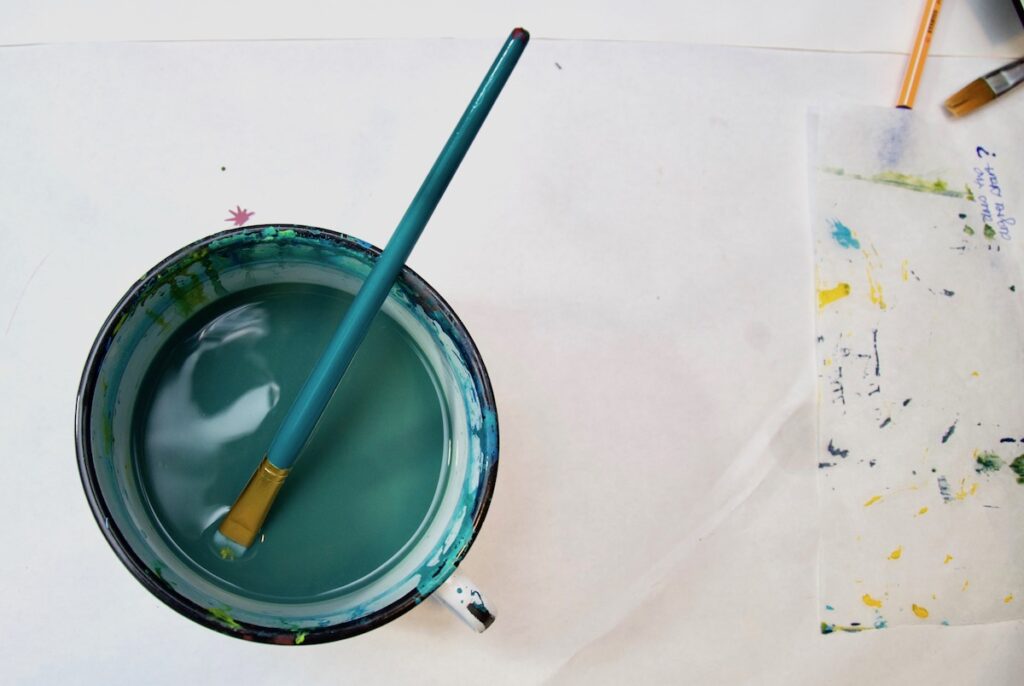As an art teacher, you don’t need to be an artist, but you do need to make art. You’re probably agreeing, but also getting ready to say, “But I don’t have the time or space!”
Let’s explore a mindset shift that will give you both the time and space to make art.
Ready? Here it is: Making art is professional development.
Let’s say that one more time, this time with excitement, “Making art is professional development!” Why? Because creating art helps to remind you of and connect you to the creative process. And connecting to the creative process makes you a better art teacher.
Before we dive deep into this new mindset, let’s agree on a few things.
- You don’t have to make good art.
- You don’t have to be afraid of making bad art.
- You don’t have to spend hours making art.
- You don’t need a studio to make art.
You Don’t Have to Make Good Art
As you prepare to create, remind yourself you don’t have to make good art, and you likely will make a lot of bad art.
While we tell our students it’s okay to fail, we often don’t extend the same forgiveness to ourselves.
As you create both good and bad art, reflect on how you feel. Remember, your students feel the same way.
How do you respond when you make a mistake? How do you feel when you make something that doesn’t look like the idea you had in your head? How do you get yourself to create when you “don’t feel like it?” How do you get started when you don’t have any ideas?

You Don’t Have to Spend Hours Making Art
Making art doesn’t have to take a lot of time. While it’s great if you can dedicate a solid chunk of time to creating, it’s also okay if you can’t. Start by committing to ten minutes a day or even ten minutes a week. The most important thing is that you make a plan and start.
Remember, we ask our students to find the time to make art. We need to do the same.
You Don’t Need a Studio to Make Art
While it is a bit nicer and easier to create if you have a dedicated art space, it isn’t essential.
If you don’t have much space, use that as one of your constraints, and think about what you can make with the space, time, and supplies you have.
For example, I wanted to start a short and playful daily creative practice. I decided to do quick paintings in an old, already used sketchbook. To keep things simple, I use one brush, one cup of water, and a few paints. I rinse the brush in the water, but don’t bother with paper towels, and have a mini clipboard set up as my palette. I can paint quickly, I don’t need much space, and I don’t need to worry about cleanup.
Now that we’ve explored some roadblocks to making art, let’s go a step further and unpack how to treat making art as professional development.
You find time to go to meetings, to attend professional development, and to take classes. Let’s start thinking about making art as professional development. Better yet, let’s find ways to have making art count toward professional development hours.
Start by looking at your school calendar. What days are blocked off for professional development? Look at the topics for those days, and reflect on how those topics relate to you and your classroom. If they don’t relate, create a proposal of what you’d like to do. Make the proposal clear, concise and connected to standards when possible. Finally, present it to your administration for approval.
Here are 5 ideas to get you started.

1. Get together with the visual arts teachers in your district to teach each other.
For example, if you have one teacher who has a strong understanding of oil painting and the rest of you don’t, have that teacher lead an oil painting workshop. As all of the art teachers gain a deeper and broader understanding of mediums and topics, it allows for ease in scheduling. (This is the part your administration likes to hear.)
2. Research local artists and see if you can schedule a studio visit.
This is a great way to learn a new skill or technique, but also a powerful community connection. You might continue to build the relationship by inviting the artist into your classroom. Or gather information about being a working artist to share with your students. As you present this to your administration, be sure to point out the community and career connections.
3. Find an online video course that focuses on making art.
Select a course on a topic or medium with which you’re not comfortable, and use it as a time for you to create, but also to get new ideas to share with your students. Art Ed PRO has many media packs that might interest you. Check out topics like mosaics, monoprinting, hand-built ceramics, and more. Plus, each Learning Pack comes with helpful downloads to take what you learn right into your classroom.
4. Visit a nearby art school or college with an art program.
Most colleges are excited to have art teachers learn more about their program. Ask if they can lead you in a mini-workshop while you’re there. Tell your administrator you’re working on gathering information to help your students be informed and prepared about their post-secondary education options.
5. Go to an art museum.
Spend time looking at art, and sitting down to sketch while you’re there. You can use this as a way to prepare for or plan a field trip or to connect with the museum’s education department.
When you’re making art, it’s almost always going to lead to new ideas and techniques to share with your students.
After you’ve thought about how to use days that are already scheduled, check to see if you need to earn further hours. If you do, get creative.
Take a studio art course online, or find a continuing education course at a local college that will count toward hours and sign yourself up. AOE has many studio courses where you can make art and learn how to better teach your students at the same time. You can see all of the offerings here. Just look for the word “Studio” in the title.
You can also look for workshops or conferences that have creative making components and register.
You likely became an art teacher because you believe art matters, but also because you love creating. It’s time to switch your mindset, get creative with your schedule, and start making art on a regular basis.
What is one professional development activity you enjoyed that allowed you to make art?
What is your biggest roadblock to making art on a regular basis?
Magazine articles and podcasts are opinions of professional education contributors and do not necessarily represent the position of the Art of Education University (AOEU) or its academic offerings. Contributors use terms in the way they are most often talked about in the scope of their educational experiences.





